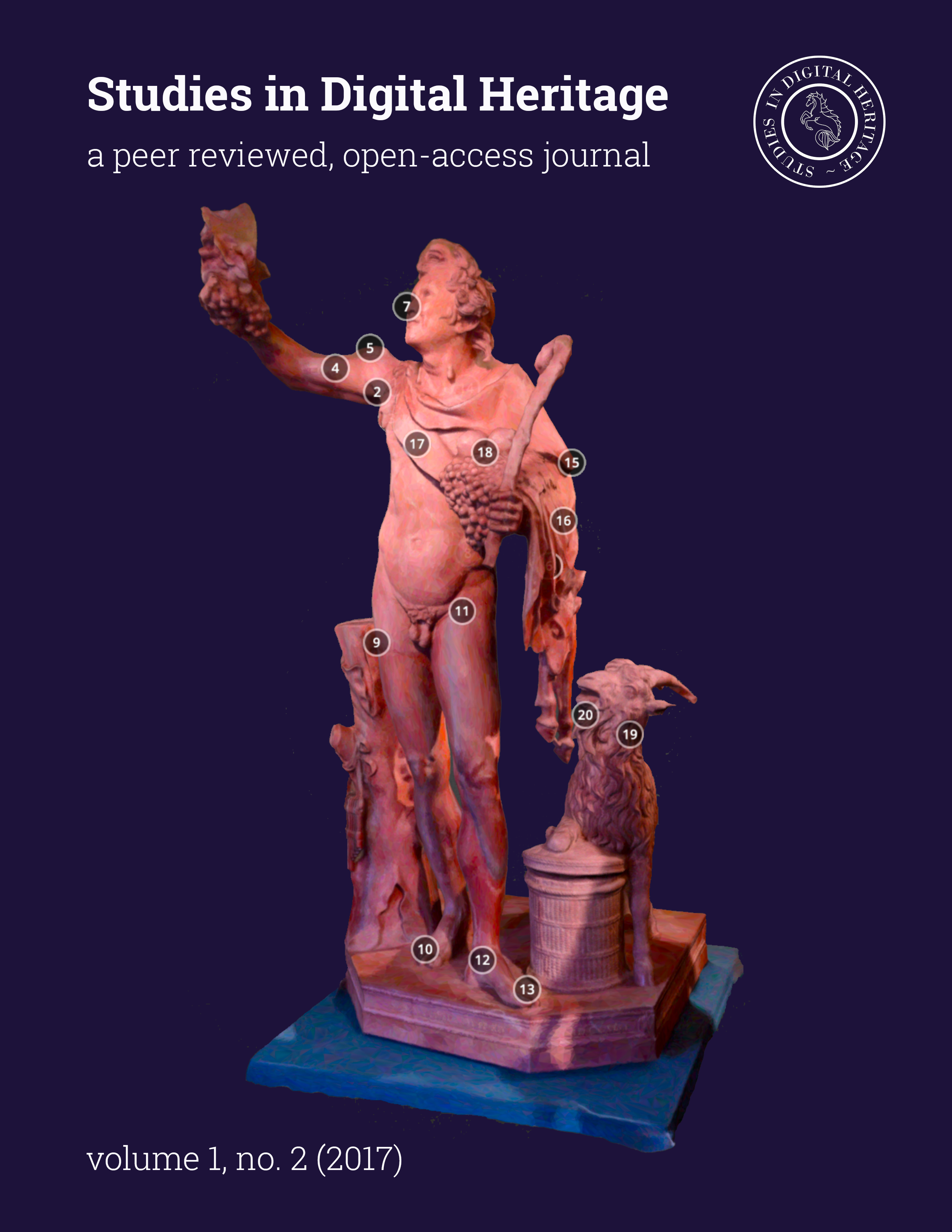Digital 3D reconstructed models A proposition for structuring visualisation workflows using semantic technologies for recommendations
Main Article Content
Abstract
Downloads
Article Details
From 18 May 2018, the contents of Studies in Digital Heritage are licensed under a Creative Commons Attribution-NonCommercial 4.0 International License (CC BY-NC 4.0). Our submitting authors pay no fee and retain the copyright to their own work.
How this works: to submit their work to the journal, authors grant Studies in Digital Heritage a nonexclusive license to distribute the work according to a CC BY-NC 4.0 license. Once an article is published, anyone is free to share and adapt its contents—provided only that they do so for noncommercial purposes and properly attribute the shared or adapted information. Details of these terms can be found on the Creative Commons website.
Download SDH’s full author agreement here
Studies in Digital Heritage will insert the following note at the end of any work published in the journal:
© [Year] by the authors. This article is an open-access article distributed under the terms and conditions of the Creative Commons Attribution License CC BY-NC 4.0 (https://creativecommons.org/licenses/by-nc/4.0/).
References
F. Baader. 2003. The Description Logic Handbook: Theory, Implementation and Applications. Cambridge: Cambridge University Press.
T. Berners-Lee. 2006. Artificial Intelligence and the Semantic Web. Retrieved February 10, 2017 from DOI= http://www.w3.org/2006/Talks/0718-aaai-tbl/Overview.html, 14.
K. W. Brodie et al. 2004. Visualization Ontologies: Report of a Workshop Held at the Nationale Science Centre. Report e-Science Institute 2004.
J. Heflin. 2004. OWL Web Ontology Language - Use Cases and Requirements. (2004). Retrieved February 1, 2017 from https://www.w3.org/TR/2004/REC-webont-req-20040210/.
T. Hofweber. 2011. Logic and Ontology. Stanford Encyclopedia of Philosophy. (2011). Retrieved February 1, 2017 from https://plato.stanford.edu/entries/logic-ontology/.
A. Karmacharya et al. 2016. Knowledge Based Recommendation on Optimal Spectral and Spatial Recording Strategy of Physical Cultural Heritage Objects. In Proceedings of the Tenth International Conference on Advances in Semantic Processing, Semapro 2016. Venice: IARIA, 49–59.
M. Grellert et al. 2010. Ephesos - Byzantinisches Erbe des Abendlandes. Digitale Simulation und Rekonstruktion der Stadt Ephesos im 6. Jahrhundert. In Falko Daim and Jörg Drauschke (eds.), Byzanz - das Römerreich im Mittelalter. Schauplätze. Monographien des RGZM 84, 2, 2. Mainz: Verlag des RGZM, 241–254.
P. Kuroczyński et al. 2015. Virtual Museum of Destroyed Cultural Heritage - 3D Documentation, Reconstruction and Visualisation in the Semantic Web. In Virtual Archaeology (Methods and benefits). Proceedings of the Second International Conference held at the State Hermitage Museum 1-3 June 2015. Saint Petersburg, 54–61.
F. Mangartz. 2010. Die byzantinische Steinsäge von Ephesos. Baubefund, Rekonstruktion, Architekturteile. Monographien des RGZM 86. Mainz: Verlag des RGZM.
C. Mazzola. 2009. What to do with “Large Quantity Finds in Archaeological Collections” – A KURproject. News in Conservation 6 (December 2009), 6.
C. Metral et al. 2012. An Ontology of 3D Visualization Techniques for Enriched 3D City Models. In Usage, Usability, and Utility of 3D City Models–European COST Action TU0801 (p. 02005). EDP Sciences.
A. M. Pérez et al. 2010. An Enhanced Visualization Ontology for a Better Representation of the Visualization Process. In International Conference on ICT Innovations. Berlin, Heidelberg: Springer-Verlag GmbH, 342–347.
M. Pfarr-Harfst and S. Wefers. 2016. Digital 3D Reconstructed Models - Structuring Visualisation Project Workflows. In M. Ioannides et al. eds. EuroMed 2016, Part I, LNCS 10058 (2016) 544–555. DOI: 10.1007/978-3-319-48496-9_43.
M. Pfarr-Harfst. 2016. Typical Workflows, Documentation Approaches and Principles of 3D Reconstructions. In M. Pfarr-Harfst et al., eds. How to Manage Data and Knowledge Related to Interpretative Digital 3D Reconstructions of Cultural Heritage? Berlin, Heidelberg: SpringerVerlag GmbH, 32-46.
R. Potter and H. Wright. 2006. An Ontological Approach to Visualization Resource Management. In International Workshop on Design, Specification, and Verification of Interactive Systems. Berlin, Heidelberg: Springer-Verlag GmbH, 151-156.
A. Pülz. 2010. Das sog. Lukasgrab von Ephesos: eine Fallstudie zur Adaption antiker Monumente in byzantinischer Zeit. Forschungen in Ephesos 4,4 (2010). Wien: Verl. der Österr. Akad. der Wiss.
G. Shu et al. 2008. Bringing Semantics to Visualization Services. Advances in Engineering Software, 39, 6 (2008), 514–520.
V-MusT. 2013. Virtual Museums by Interaction Technology. (2013). Retrieved February 7, 2017 from http://www.v-must.net/virtual-museums/categories/interaction-technology.
M. Voigt and J. Polowinski. 2011. Towards a Unifying Visualisation Ontology. Technische Berichte / Technische Universität Dresden, Fakultät Informatik 2011, 01 (2011). Retrieved February 7, 2017 from http://nbn-resolving.de/urn:nbn:de:bsz:14-qucosa-67559.
S. Wefers. 2015. Die Mühlenkaskade von Ephesos. Technikgeschichtliche Studien zur Versorgung einer spätantiken bis frühbyzantinischen Stadt. Monographien des RGZM 118 (2015). Mainz: Verlag des RGZM.
S. Wefers et al. 2016. Development of a Platform Recommending 3D and Spectral Digitisation Strategies. Virtual Archaeology Review 7, 15 (2016), 18–27.


